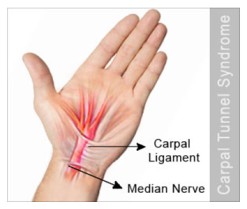CARPAL TUNNEL SYNDROME
Carpal tunnel syndrome is a painful disorder of the hand caused by pressure on your median nerve as it runs through the carpal tunnel of the wrist. Symptoms include numbness, pins and needles, and pain (particularly at night).

What's the Cause of Carpal Tunnel Syndrome?
Anything that causes swelling inside the wrist can cause carpal tunnel syndrome, including repetitive hand movements, pregnancy and arthritis.
Carpal Tunnel Syndrome symptoms begin when the pressure inside the tunnel becomes too high. This results in your median nerve becoming compressed as it passes through the small tunnel.
The carpal tunnel pressure increases when either of two things happens :
- The tunnel space decreases, such as when the wrist swells e.g. after a traumatic injury, partial subluxation of the carpal bones or fracture or tenosynovitis.
- When the contents of the tunnel (median nerve, blood vessels and tendons) enlarge.
Both of these situations increase the pressure on the nerve, leading to the carpal tunnel symptoms.
Symptoms of Carpal Tunnel Syndrome
Carpal Tunnel Syndrome (CTS) sufferers will usually experience the following symptoms in their hand or fingers:
- hand pain or aching
- pins and needles
- numbness esp. at night off with wrist flexing
- burning
- weakness or cramping
- perceived swelling
The symptoms are usually worse at night and your grip will weaken as the condition progresses. Eventually you will notice muscle atrophy of the thenar (thumb) muscles and loss of hand function.

Diagnosis
Generally diagnosis of carpal tunnel syndrome is based on your symptoms.
Various tests such as Phalen’s test, Tinel’s test or the wrist flexion/median nerve compression test that compress the carpal tunnel is used.
Ultrasound may reveal median nerve entrapment. X-ray may identify coexisting pathologies.
Treatment
- Rest & Patient Education
Resting from the aggravating cause is important. Education and awareness about what the symptoms and what positions or activities potentially cause carpal tunnel syndrome are important. - Night Wrist Splint
A night time wrist splint is beneficial to eliminate wrist bending and therefore carpal tunnel symptoms. - Physiotherapy
Physiotherapy is beneficial for most carpal tunnel sufferers especially in mild to moderate cases. - Ultrasound Therapy, Acupuncture, Massage & Yoga
- Carpal Tunnel Surgery
Low Level Laser Therapy Treatment for Carpal Tunnel
Low Level Laser Therapy (LLLT) is the application of red and near infrared light over injuries to stimulate cellular repair. LLLT has a powerful anti-inflammatory effect as well as a healing effect.
Low level laser therapy (LLLT) demonstrated effectiveness for conservative treatment of CTS, due to LLLT biophysical effect in neural tissue that can facilitate its regeneration.
Neurological effect: Low level laser modulates the inflammatory effects in injured tissue through altering the distribution of inflammatory cells, reduction of oedema, haemorrhage, and necrosis Edema reduction would accelerate resolution of inflammatory process.
It prevents motor cell degeneration, induces Schwann cell proliferation and higher neural metabolism, with increasing myelinization and axonal regeneration
You will be encouraged to move the affected area within range of movement/pain but not exert stretch or force during the healing phase.
Once tissues are healed, pain is eliminated and normal range of motion and function is restored. Then muscle and tendon strength and flexibility can be addressed with graduated exercises and stretching.
LLLT has no known side effects, is safe and effective.

